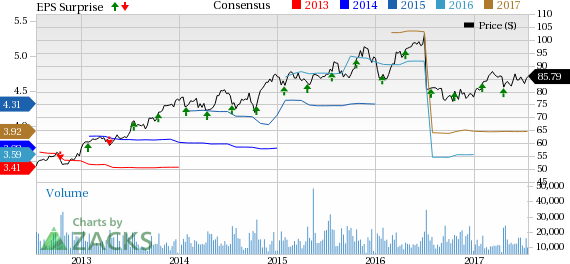Danaher Corporation (NYSE:DHR) reported adjusted earnings of 99 cents per share in second-quarter 2017, beating the Zacks Consensus Estimate of 97 cents by 2.1%. Moreover, adjusted earnings rose 10.0% on a year-over-year basis.
The bottom line also steered past the company’s guided range of $0.95–$0.98.
The upside in the company’s bottom line can be attributed to its effective Danaher Business System (“DBS”), which provides a set of philosophies, processes and toolsets to drive improvement. Moreover, a decent top-line performance supplemented earnings rise.
Revenues by Segment
Danaher reported total sales of $4,510.1 million, reflecting an increase of 6.3% year over year. In addition, the figure surpassed the Zacks Consensus Estimate of $4,496 million.
Improvement in second-quarter revenues was due to positive contributions from both non-core and core businesses. While acquired businesses contributed 6.0% to overall growth, core businesses contributed 2.0%, both on a year-over-year basis. The company’s recent large acquisitions, Pall and Cepheid, contributed significantly toward the top-line increase.
Life Sciences segment revenues rose 4% year over year to $1,384 million. Operating margin for the quarter expanded 150 basis points (bps) to 16%. Sales growth of this segment was driven by robust market traction of mass spectrometers, microscopy, flow cytometry and genomics products. Impressive rise in the operating margin was driven by higher sales volumes and incremental year-over-year cost savings associated with restructuring actions.
Revenues at the Diagnostics segment increased 14.5% year over year to $1,440 million. Impressive performance of clinical business in China and robust performance of acute care diagnostic and pathology diagnostics business proved conducive to growth of this segment. However, operating margin at the segment contracted 760 bps year over year, to 10.9%. The fall is attributable to higher costs associated with new product development and higher restructuring and impairment charges.
Revenues at Dental came in at $703 million, falling 1.5% on a year-over-year basis. Operating margin rose 30 bps to 15.6%. Lower demand for dental consumable product lines in North America and Western Europe proved to be a drag on the top line of this segment. Also, price decreases impacted this segment negatively. Rise in operating margin is attributable to incremental year-over-year cost savings associated with the restructuring actions.
At the Environmental & Applied Solutions segment, revenues were up 4.5% year over year to $983 million. Solid performance across all the business lines, namely, water quality, analytical instrumentation, chemical treatment solution and ultraviolet water disinfection in end markets drove growth for this segment. Operating margin rose 70 bps to 23.9%. Cost savings associated with restructuring actions benefitted operating margin.
On a year-over-year basis, operating profit margin contracted 150 bps to 15.2%. Gross margins were down 110 bps to 55.0%. Both operating and gross margin decline is attributable to restructuring and impairment charges, which completely offset benefits of higher sales volumes and incremental year-over-year cost savings.
Liquidity
Danaher exited the second quarter of 2017 with free cash flow of $891.9 million compared with the year-ago figure of $835.7 million.
Guidance
Concurrent with the earnings release, Danaher provided its guidance for third-quarter 2017. The company projects adjusted earnings per share in the range of $0.92–$0.96.
Furthermore, Danaher raised its full-year 2017 adjusted earnings guidance. It now expects adjusted net earnings per share to lie in the range of $3.90–$3.97 compared with the earlier guided range of $3.85–$3.95. Overall, the company reported impressive key metrics largely driven by its effective business model, the DBS. The model focuses on three critical areas – quality, delivery, and cost & innovation.
Our Take
Danaher continued its impressive growth momentum, with both top- and bottom-line beats during the second quarter. DBS continues to be its biggest strength. The company’s tried and tested business model has proved to be the fundamental growth driver, fueling revenue, margins, cash flow and earnings improvement. Furthermore, two most recent large acquisitions – Pall and Cepheid – are proving to be major profit churners.
Danaher remains confident about the uptick of its order, which will eventually accelerate its core revenue growth. Furthermore, positive industry trends like new regulations from the Chinese Food and Drug Administration are expected to act as tailwinds. The upward guidance revision, which is likely to go down well with investors, signals bright days ahead for the Zacks Rank #3 (hold) company.
Stocks to Consider
Some better-ranked stocks in the industry are Crane Co. (NYSE:CR) , 3M Company (NYSE:MMM) and ITT Inc. (NYSE:ITT) . Each stock carries a Zacks Rank #2 (Buy). You can see the complete list of today’s Zacks #1 Rank (Strong Buy) stocks here.
Crane has an excellent earnings surprise history with an average positive surprise of 8.4% over the trailing four quarters, beating estimates all through.
3M delivered an average positive earnings surprise of 1.3% for the trailing four quarters, beating estimates each time.
With three beats over the trailing four quarters, ITT has an average positive surprise of 8.2%.
3 Top Picks to Ride the Hottest Tech Trend
Zacks just released a Special Report to guide you through a space that has already begun to transform our entire economy...
Last year, it was generating $8 billion in global revenues. By 2020, it's predicted to blast through the roof to $47 billion. Famed investor Mark Cuban says it will produce ""the world's first trillionaires,"" but that should still leave plenty of money for those who make the right trades early. Download Report with 3 Top Tech Stocks >>
3M Company (MMM): Free Stock Analysis Report
Danaher Corporation (DHR): Free Stock Analysis Report
ITT Inc. (ITT): Free Stock Analysis Report
Crane Company (CR): Free Stock Analysis Report
Original post
Zacks Investment Research

